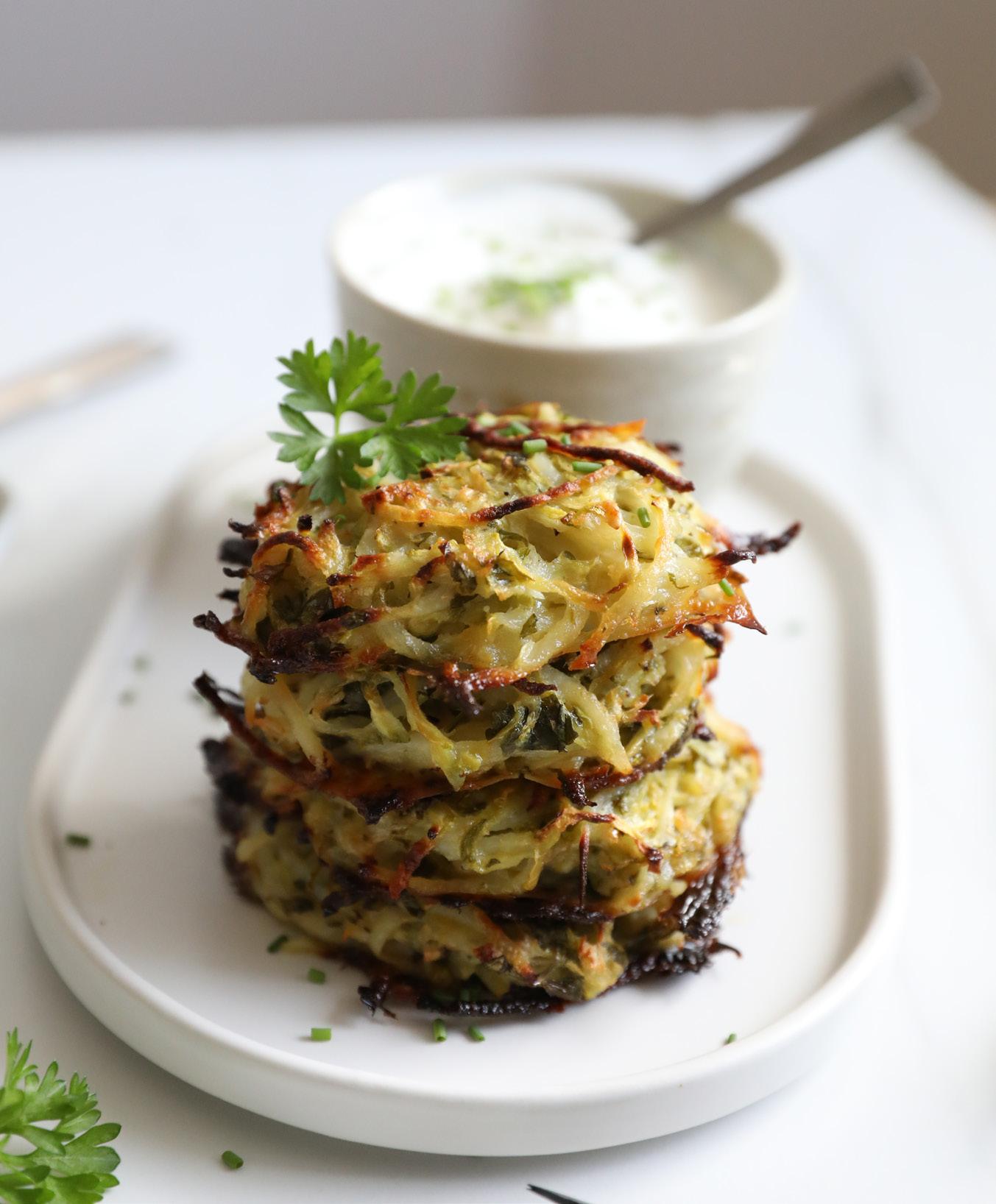
8 minute read
Foodie
TASTE OF THE TOWN
HOLIDAY BRISKET
INGREDIENTS
5-7 lbs brisket, first or second cut (do not trim fat - especially if it's grass fed) 1/4 cup extra virgin olive oil, divided 2 large brown onions, peeled and sliced 1 lb carrots, peeled and sliced 1 lb celery, peeled and sliced 28 oz tomatoes - whole, diced, or crushed (1 large can) 10 peeled whole garlic cloves 1/2 cup brown sugar 1/4 cup vinegar (I like apple cider vinegar, but white vinegar works too) 2 cups beef or chicken broth, divided Salt and pepper
DIRECTIONS
Preheat oven to 300 degrees F. Rinse the brisket and pat dry. Rub both sides of the meat with black pepper and salt.
Heat a large skillet over a medium flame on the stovetop. Drizzle 2 tbsp of olive oil into the pan. Brown the brisket on both sides—it will take 4-5 minutes per side. A large brisket may overlap the edges of the skillet; you can brown it in stages, letting half the brisket overlap the edge, then adjusting it to brown the other half.
While brisket is browning, pour canned tomatoes, garlic, brown sugar, apple cider vinegar, and 1 ½ cups broth into a blender or food processor. Add 2 tsp of salt (or 1 tsp if using a salted kosher cut of brisket) and ¼ tsp of black pepper. Pulse till garlic is chopped small and all ingredients are combined.
Remove the browned brisket from the skillet.
Drizzle 2 tbsp more olive oil in the pan and add the sliced onions. Saute them over medium high for a few minutes until they begin to soften and shrink in size.
Add the carrot and celery slices. Sauté for another 5-6 minutes until the onions are soft and browning and the vegetables are fragrant.
Pour the vegetables out of the skillet and onto a plate, reserve. Add 1/2 cup beef stock or chicken stock into the skillet and let it heat up. Use a spatula to gently scrape up any brown bits and pan juices that are clinging to the skillet. Turn off heat.
Pour half of the tomato mixture into a large roasting pan.
Place brisket on top of the tomato sauce, fat cap facing up.
Pour the sauteed vegetables across the top of the brisket, along with the broth and brown bits.
Pour the remaining tomato sauce over the top of the vegetables and brisket.
Cover the roasting pan tightly with a layer of parchment paper followed by a layer of foil. The parchment forms a protective layer between the meat and sauce (which is acidic) and the foil.
Place brisket in the oven. Let it roast undisturbed for 5 to 7 hours. It will take about 1 hour per pound of meat (leaner cuts of meat like grass fed may take longer—test for doneness). Brisket is ready when it flakes tenderly when pierced with a fork. You can let it cook even longer for a soft, shredded texture if that’s what you prefer. When fully cooked, the brisket will have shrunk in size.
I recommend making this brisket ahead; allowing it to sit in the refrigerator for 1-2 nights will improve the flavor.
Remove brisket from the pan and let it rest on the cutting board fat-side up for 20-30 minutes. Meanwhile, pour the sauce and vegetables from the roasting pan into a smaller saucepan. Skim fat from the surface of the cooking sauce, then reheat the sauce till hot (not boiling).
Cut fat cap off the brisket, then cut the brisket in thin slices against the grain. Serve topped with hot tomato sauce and softened veggies.

CLASSIC POTATO LATKES
INGREDIENTS
2 1/2 lbs potatoes (I prefer Yukon Gold) 1 large onion, shredded 3/4 cup matzo meal or bread crumbs 2 large eggs, beaten 1 tbsp potato starch, or more if needed 1 1/4 tsp salt, or more to taste 1/2 tsp pepper Avocado, peanut or grapeseed oil for frying (about 1 1/2 cups - choose an oil with a high smoke point) 1/4 cup schmaltz (optional)
DIRECTIONS
Before you begin making the latkes, place your wire cooling rack close to the area where you will be frying the latkes. Place a layer of paper towels below the cooling rack to catch excess oil.
Cut the potatoes into large chunks and shred using a hand grater or food processor shredding attachment with large holes (large shreds). I really recommend using the food processor, it saves a ton of time and will help you avoid tears when grating the onion.
Place grated potato into a bowl and immediately cover with cold water.
Meanwhile, grate the onion using the grater or food processor attachment with fine holes (small shreds).
Place drained potato shreds and grated onion in the center of a clean tea towel or multiple layers of cheesecloth. Wrap the shreds up in the cloth, twisting the cloth to secure the bundle, and squeeze firmly to remove excess liquid from the shreds.
Pour potato and onion into the clean dry bowl. Stir the shreds with a fork to make sure the grated onion is evenly mixed throughout the potato shreds.
In a skillet, add oil to reach a depth of 1/8 inch. If using schmaltz, add 1/4 cup to the oil. The schmaltz will add more savory flavor to the latkes. Heat slowly over medium to about 365 degrees F.
While oil is heating, use the fork to stir the matzo meal, beaten eggs, potato starch, salt and pepper into the potato and onion shreds. Add salt and pepper to taste; I add about 1 1/4 tsp salt and 1/2 tsp pepper. You can sprinkle on more salt to taste after cooking, if desired. Take care to make sure the egg and seasonings are fully mixed throughout the potato shreds.
Scoop up 3 tbsp of the potato mixture and shape into a tightly compacted disk. Place the disk carefully into the hot oil. Latkes can break apart at this point, they’re very delicate. If you can get them into the hot oil in one piece, chances are they will stick together – frying them is like the “glue” that holds them together. It takes a gentle touch, and it may take you some practice to get the “feel” for it.
The oil should sizzle, but not pop when the latke hits it; if the oil jumps wildly or smokes, it is too hot. If it only bubbles weakly, the oil is not hot enough. Use the first latke to test the oil temperature, and don’t fry a whole batch until the temperature is right.
Continue shaping the latkes in this way, using 3 tablespoons of potato mixture for each latke. Fry in batches of 4-5 latkes at a time (no more than that – don’t crowd the pan) for 2-3 minutes per side until brown and crispy.
Remove the latkes from the pan using a metal spatula and place them on the wire cooling rack to drain. I recommend serving latkes fresh within 10 minutes of frying them, if your cooking schedule permits. I

SUFGANIYOT
INGREDIENTS
1 cup warm water, heated to about 110°F (see note) 1 tablespoon instant/rapid-rise or active dry yeast (note that this is more than 1 packet) 3 cups all-purpose flour, spooned into measuring cup and leveled-off 1/4 cup confectioners' sugar, plus more for coating 3/4 teaspoon salt 1/2 teaspoon ground nutmeg 2 large egg yolks 2 tablespoons vegetable oil, plus about 2 quarts more for frying 1 teaspoon vanilla extract About 1 cup jam or jelly (or custard, Nutella, pudding, pumpkin butter, apple butter, dulce de leche, etc.), optional
DIRECTIONS
Combine the water and yeast in a small bowl and let sit until foamy, about 5 minutes.
Meanwhile, in a large bowl, combine the flour, confectioners' sugar, salt, and nutmeg. Whisk to combine and set aside.
Add the egg yolks, 2 tablespoons of oil, and vanilla to the water/yeast mixture and whisk with a fork until combined.
Add the liquid mixture to the flour mixture and stir with rubber spatula until the dough comes together. It should be a bit sticky. Cover the bowl with plastic wrap (no need to clean it first) and let the dough rise on the countertop until doubled in size, 1 to 2 hours.
Line a baking sheet with a few layers of paper towels. Line another baking sheet with parchment paper and dust heavily with flour. Generously dust a clean countertop and your hands with flour. Scrape the dough out of the bowl onto the counter and dust the dough with flour. Pat the dough into 1/4-in-thick rectangle (it should be about 10 x 12-inches in size), making sure the bottom doesn't stick and adding more flour to the counter and your hands as needed. Using a pizza wheel or very sharp knife, cut the dough into 24 two-inch squares and transfer to the floured baking sheet, leaving a little space between the squares. Sprinkle the squares lightly with flour.
Add enough of oil to a large Dutch oven or heavy pot to measure about 2 inches deep and heat over medium heat to 350°F. (If you don't have a candy/ deep-fry thermometer, drop a 1-in cube of bread in the oil; if it takes about 1 minute to get golden brown, the oil is at the right temperature.) Place 6 dough pieces in the oil and fry until golden brown, about 3 minutes, flipping halfway through frying. Adjust the heat, if necessary, to maintain the oil temperature between 325°F and 350°F. Using a slotted spoon, transfer the donuts to the paper towel-lined baking sheet. Repeat with the remaining donuts.
When the donuts are cool enough to handle, use a paring knife to puncture the side of each to form a pocket in the center. Place the tip of a squeeze bottle or piping bag into the pocket and squeeze 1 to 2 teaspoons of jam or jelly inside. (Alternatively, if you don't have the right tools or just don't want to bother, serve the filling on the side.)
Using a fine sieve, dust the donuts generously with confectioners’ sugar. Serve warm.










